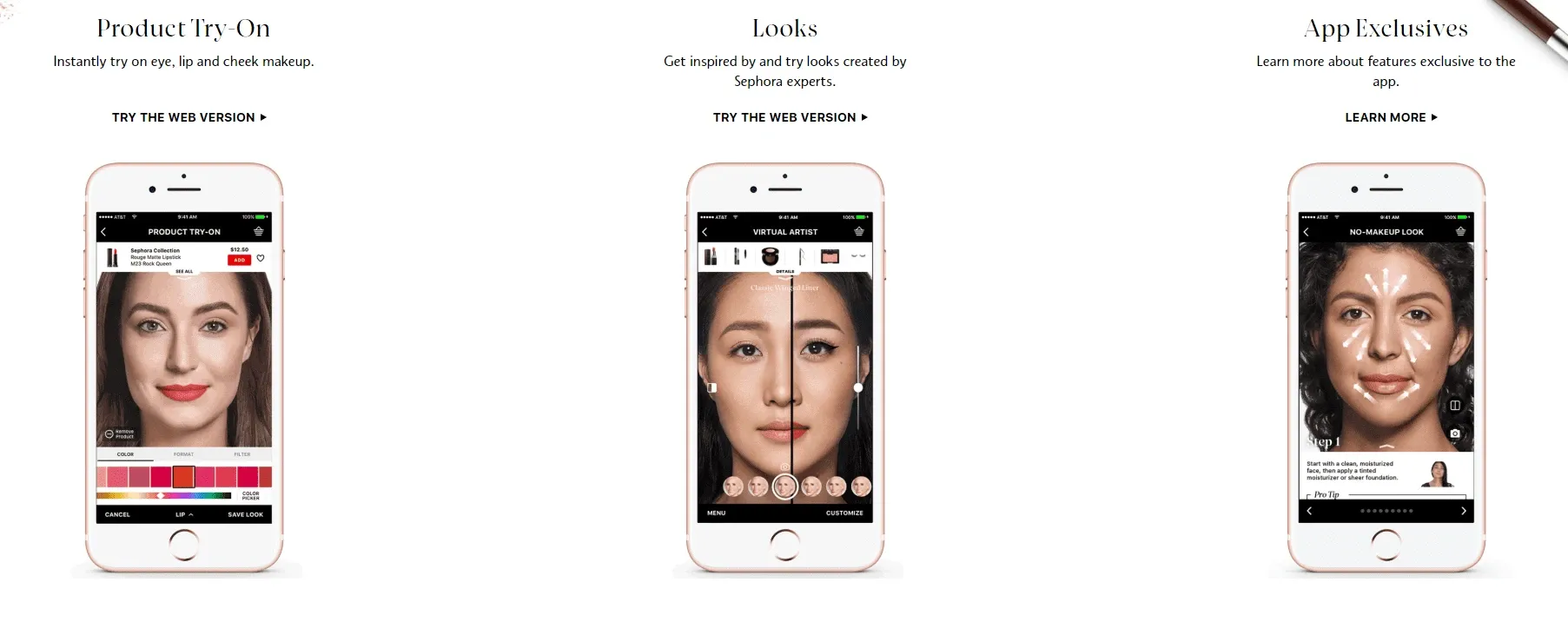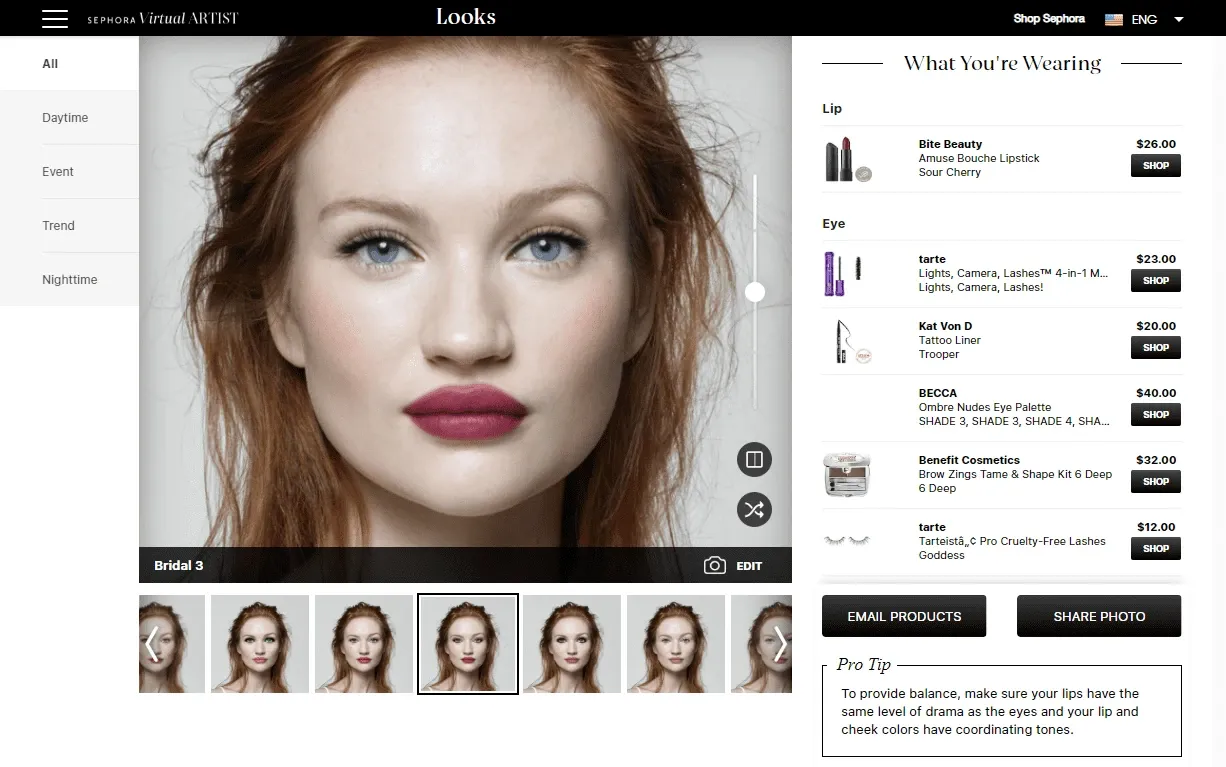How is Augmented Reality marketing related to your business?
Published on 10/31/2019 by Yahong Zhang
Augmented Reality Marketing is a new technique where businesses integrate the advanced AR technology to marketing and sales activities. It is now embraced, in the luxury industry especially, as an efficient tool to enhance the connectivity with their customers and therefore increase online sales.
While people used to walk around in the malls and select a shop that looked the most appealing to them, they are now roaming the webpages and searching the e-commerce sites where they expect to find the best experience.
Similar to the brick and mortar stores, presentation is everything for e-commerce performance. Failure to offer an adequate shopping experience may cause customers to leave within seconds, especially when they have other options available on their fingertips.
In the year 2017, Saetang conducted a study and stated that good user experience would not only encourage the customers to buy the products but also inspire them to recommend the e-commerce site to others.
Hence, it is vital to design your e-commerce site in a way that is not only eye-catching but also offers the best user interaction to provide the optimal customer engagement.
How does augmented reality work?
Augmented Reality has been a topic of interest for decades. Berryman stated in her study in 2012, that the term Augmented Reality is said to be first coined by Tom Caudell and David Mizell back in 1990, and the concept of AR is even much older.
As defined by Mekni and Lemieux in their article in 2014, Augmented Reality is the technology that combines the characteristics of both the real and virtual reality and provides an interactive 3D product presentation.
The four main components necessary in any AR setting are displays, input devices, tracking and computers. However, how these components are assembled can vary according to the requirements of the application.
Unlike Virtual Reality technology, Augmented Reality does not bring the user into a virtual environment, instead it provides connectivity with the real world by superimposing the virtual objects over the existing reality.
Tim Perdue states in his article in 2019 that Augmented Reality has applications in various industries which include military, medical procedures, navigation, sightseeing, and advertising and promotion [^4]. In military sector, AR is used to provide battlefield advantages for the soldiers, for example, it offers information at a glance, and reduces distractions. In medical practices, AR technology is used in order to perform surgery in a controlled environment. With this technology, surgeons will have the advantage of enhanced sensory perception and this mitigates the risks associated with the operations.
In the navigation system, AR offers a simplified driving experience and provides the navigation information readily. Augmented Reality technology has also innovated the tourism industry by replacing tour guides; as now, tourists can walk around historic sites and see the facts and figures associated with the place through their phones.
Finally, the implication of AR in advertising and promotions is now widely used across the world as it provides a unique form of enhancing the connectivity with the customers and therefore improves customer engagement.
AR applications and impacts on eCommerce performance
Augmented Reality is an emerging technology that is receiving immense attention from multiple retail giants such as Adidas and L’Oréal, that are trying to maximize customer engagement by providing them with an interactive 3D product presentation.
AR is now favored by both business and clients
Yim, Chu, and Sauer claimed in their report in 2017 that as the popularity of Augmented Reality is increasing, its market size is expected to grow too from $640.2 million in 2015 to $120 billion by 2020.
In addition, Nyma Malik stated in her article in 2018 that around 40% customers are willing to spend more on a product if they can try it through Augmented Reality, due to the fact that this experience makes easy for them to explore the options and to customize or personalize the products.
Also, 70% of people are expected to be more loyal too to brands incorporating AR as their shopping experience.

Many companies in the luxury industry are opting for Augmented Reality in order to increase the connectivity with consumers and gain a competitive advantage in the market, big names including L’Oréal, Baume, Sephora, Adidas, Nike and Snap.

For example, Sephora the cosmetic brand is using the technology to allow their clients to virtually try make-ups on their faces and see the results real time without physically applying anything, which would ruin their own makeups and cause both financial and human resources to help the process.
Such implementation of AR technology for customer service has been a huge success at Sephora as it has strengthened both the physical and digital reputation of the brand and boosted their sales considerably.
Increasing number of big names are digging into AR to boost sales
In 2018, Paine provided a list of enterprises that are successfully leveraging the AR technology to strengthen their brand images and enhance customer engagement, namely [^7]:
Ikea introduced an application with AR view, through which their customers can place virtual products such as furniture or speakers in the physical environment of their homes and see real time how the furniture will look like through smartphone screens.
Amazon has developed similar an application for selected products such as furniture and speakers.
eBay launched the feature in their eCommerce application where the users can view and select the right packaging for shipping.
Amikasa goes even further. While allowing clients to simply view the products, the brand also enables user to customize the products, such as to choose the color and texture, and then to place the order after visualizing how well the furniture will fit in their homes besides existing furniture and color schemes.
Potential Benefits for customers
Radu and Schneider state in their article in 2019, that Augmented Reality has various applications in the field of e-commerce, especially due to its ability to present 3D objects in actual reality [^8].
An interactive 3D product presentation through Augmented Reality enhances customer engagement by displaying the virtualized version of products in the physical environment.
Augmented Reality can also save the time for customers by allowing them to virtually try on different products with help of an equipment like an app and to decide which one suits them best, without having to physically apply the product on themselves.
With this technology, e-commerce sites can also allow online customization or personalization of products, where customers can do their own designs and create something that best satisfies their needs.
Another application of this technology in the e-commerce sector can be seen in digital marketing. In this case, information is added to the physical object in the form of an image, a few lines of texts or a video.
Various companies in the luxury industry have successfully adopted this new trend of marketing in collaboration with Snapchat.
Augmented reality example
Another example of integrating Augmented Reality into e-commerce platforms can be taken from Baume, a high- end watchmaking brand.
The company is currently offering customers a 3D configurator by Hapticmedia embedded in their website, which provides an interactive 3D product presentation that enables customers to do online customization so to create their own unique watch designs.
Available options include a selection of dial designs, colors, frames, hand styles and personalized engraving on the back of the core, over 2,000 possible combinations.
In addition, the brand also offers clients the opportunity to virtually try on the customized watch directly on their wrists using a paper wristband. This practice largely improves the shopping experience for customers by engaging and involving them in the design process while causing little extra costs to the company.
Marie Chassot, Head of Baume, said after the project: “the results of these technological innovations are spectacular: 3D rendering that is virtually identical to the physical watch; perfect fluidity for increased configurator user-friendliness and an augmented reality wristband that enables customers to try on their watch without physically handling it. Hapticmedia understood our needs, both in terms of design and customer experience and came up with very inventive ways to develop them!"
Conclusion
Augmented Reality is an upcoming technology that can have astronomical implications in transforming the e-commerce industry and enhancing interaction with consumers.
As clients, especially those in the high end market are inclined to try out advanced technologies to have a more engaging and interesting shopping experience. Brands are expected to keep up with their demands with the help of emerging technologies such as AR solutions.
Companies that have already adopted this technology prove to us that Augmented Reality is an effective approach to increases the competitive advantage and ultimately revenues by improving customer engagement and shopping experience.
References
[^1]: Saetang, S. (2017, August). The E-Commerce strategies responding to the UX design. In 2017 10th International Conference on Ubi-media Computing and Workshops (Ubi-Media) (pp. 1-6). IEEE.
[^2]: Berryman, D. R. (2012). Augmented reality: a review. Medical reference services quarterly, 31(2), 212-218.
[^3]: Mekni, M., & Lemieux, A. (2014). Augmented reality: Applications, challenges and future trends. Applied Computational Science, 205-214.
[^4]: Perdue, T. (2019). Applications of Augmented Reality. Lifewire. Retrieved from: https://www.lifewire.com/applications-of-augmented-reality-2495561
[^5]: Yim, M. Y. C., Chu, S. C., & Sauer, P. L. (2017). Is augmented reality technology an effective tool for e-commerce? An interactivity and vividness perspective. Journal of Interactive Marketing, 39, 89-103.
[^6]: Malik, N., (2018). How Augmented Reality can be Used in Ecommerce, Citrus Bits.
[^7]: Paine, J. (2018). 10 Brands Already Leveraging the Power of Augmented Reality. Inc. Retrieved from: https://www.inc.com/james-paine/10-brands-already-leveraging-power-of-augmented-reality.html
[^8]: Radu, I., & Schneider, B. (2019, April). What Can We Learn from Augmented Reality (AR)?. In Proceedings of the 2019 CHI Conference on Human Factors in Computing Systems (p. 544). ACM.